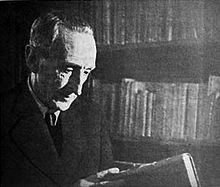Ignazio Maria Etxaide Lizasoain
Ignazio Maria Etxaide Lizasoain (born December 1, 1884 in San Sebastián , Spain , † November 14, 1962 ) was an engineer, writer and philologist of the Basque language .
Life and career
Because his family did not have a permanent residence, but commuted between San Sebastián and Vergara, he learned independently and graduated from high school in Valladolid in 1900 . He then attended the Bilbao Engineering School (Escuela de Ingenieros Industriales de Bilbao) and graduated in October 1906. The following year he joined the government of the Province of Gipuzkoa . Initially still responsible for the service of Catastro Industrial, in 1908 he was given responsibility for the local telephone network. This task became his great passion and ultimately led to the establishment of the local telecommunications company Red Telefónica Provincial.
From March 9, 1909 he held the post of engineer of the province, which included various functions as well as the management of the Red Telefónica Provincial. Under his leadership, this service also reached the most remote places in the province. Furthermore, in 1926 he introduced the first automatic telephone network in Spain, which very successfully served the capital and its surroundings. Etxaide left behind a remarkable technical bibliography, as well as numerous articles in magazines such as "Byna", "Metalurgia y Electricidad" and others, always striving for clarity and comprehensibility. On September 30, 1926 he received the silver medal of work (sp. Medalla de Plata del Trabajo). He was still responsible for the Telefonía Provincial until it was taken over on May 9, 1949 by the Compañía Telefónica Nacional de España (now Telefónica ).
His second passion was studying the Basque language (Euskara). Although it was not his mother tongue, he started studying and analyzing this language at a young age with little knowledge. As a linguist, he wrote several essays on grammar and syntax , as well as numerous articles. He also participated in magazines such as "Euskal-Esnalea", "Euskera" and the leaflet of the "Real Sociedad Vascongada de Amigos del País". From 1951 until his death he was the second president of the Royal Academy of the Basque Language (Euskaltzaindia). Due to his professional activity, his written contributions regarding the technical areas of telephony (including legislative and historical aspects, technical management of its functioning, use of the network, etc.) were particularly important.
Etxaide was a staunch Catholic, which is why he actively participated in the Church's propaganda campaigns. He co-founded the Legión Católica Española (1928), the Centro de Actuación y Propaganda Católica (1932) and the Editorial Católica de Guipúzcoa (1932). He also wrote numerous articles in Catholic and integralist newspapers such as “La Cruz” (of which he was also a co-founder), “El Integrista”, “La Constancia” and “Cruz y Verdad”.
In total, he published 33 technical manuals and several hundred articles on telephony, Basque, politics and religion. Thanks to his work in the field of telecommunications and his studies of the Basque language, the Ministry of Education, on the initiative of the Provincial Government of Gipuzkoa, granted him membership of the Order of Alfonso X the Wise .
Works
- Subfijación, prefijación y composición en el idioma euskaro (1911)
- Tratado de sintaxis en el idioma euskaro (1912)
- Apuntes de Telefonía (1921)
- El verbo vascongado (1923)
- Descripción histórica y estadística (1923)
- Comunicaciones de Guipúzcoa (1924)
- Medidas eléctricas y mecanismos. Descripción de aparatos e instrucciones de uso (1924)
- Apuntes sobre telefonía (1925)
- La Telefonía automática en Guipúzcoa alcance de todos (1925)
- La corriente telefónica: Estudio matemático de los problemas relativos a la transmisión telefónica precedida de una entrada sobre la corriente alterna (1927)
- El sistema Ericsson de telefonía automática (1928)
- Telefonearen sortze ta aurrerapena (1929)
- Resumen descriptivo, histórico y estadístico acerca de la Red Telefónica de Guipúzcoa (1929)
- Medidas de equivalente y level de transmission: Descripción de un aparato construido por la Société d´Etudes pour Liaisons Telephoniques & Telegraphiques "instaldo en el laboratorio de la red (1929)
- Tratado de subfijación, prefijación y composición en el idioma euskaro (1931)
- Sobre el origen y parentesco del pueblo euskaro y su idioma (1935)
- Lecciones sobre telefonía automática (1942)
- Desarrollo de las conjugaciones euskaras. Perifrásticas y sintéticas, respetuosas y familiares (1944)
Web links
- Enciclopedia Auñamendi
- Tratado de sintaxis del idioma euskaro, by Ignacio María Echaide
- Información de su vida y muerte
| personal data | |
|---|---|
| SURNAME | Etxaide Lizasoain, Ignazio Maria |
| BRIEF DESCRIPTION | Spanish engineer, writer and Basque language philologist |
| DATE OF BIRTH | December 1, 1884 |
| PLACE OF BIRTH | San Sebastian , Spain |
| DATE OF DEATH | November 14, 1962 |
